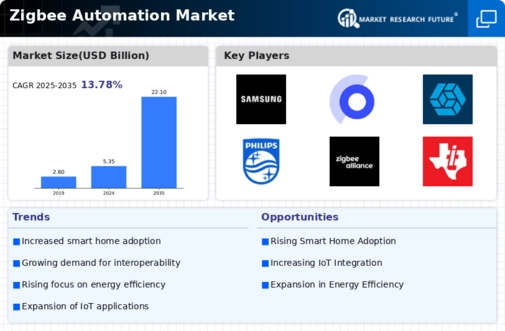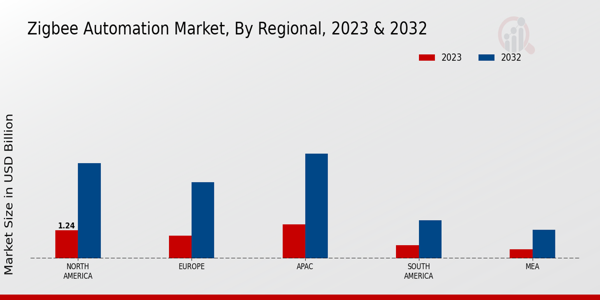Market Growth Projections
The Global Zigbee Automation Market Industry is poised for substantial growth, with projections indicating a market value of 5.35 USD Billion in 2024. This growth trajectory is expected to continue, with an anticipated market value of 22.1 USD Billion by 2035. The compound annual growth rate (CAGR) of 13.76% from 2025 to 2035 underscores the increasing adoption of Zigbee technology across various sectors. Factors such as rising consumer demand for smart home solutions, advancements in IoT technology, and increased investment in smart infrastructure contribute to this optimistic outlook. The market's expansion reflects the growing recognition of Zigbee as a leading automation solution.
Rising Demand for Smart Homes
The increasing consumer inclination towards smart home technologies drives the Global Zigbee Automation Market Industry. As households seek enhanced convenience, energy efficiency, and security, Zigbee-enabled devices become more prevalent. In 2024, the market is projected to reach 5.35 USD Billion, reflecting a growing trend in home automation. Consumers are increasingly adopting smart lighting, thermostats, and security systems that utilize Zigbee technology. This shift not only enhances user experience but also contributes to energy savings, aligning with global sustainability goals. The anticipated growth in smart home adoption indicates a robust future for the Zigbee automation sector.
Advancements in IoT Technology
The rapid advancements in Internet of Things (IoT) technology significantly impact the Global Zigbee Automation Market Industry. As IoT devices proliferate, the need for reliable communication protocols becomes paramount. Zigbee provides a robust framework for connecting various IoT devices, ensuring efficient data exchange and control. This technological evolution enhances the functionality of smart devices, making them more appealing to consumers. The integration of Zigbee with IoT applications is likely to drive market growth, as businesses and homeowners increasingly rely on interconnected systems. The synergy between Zigbee and IoT is expected to shape the future landscape of automation.
Growing Focus on Energy Efficiency
The Global Zigbee Automation Market Industry benefits from the increasing emphasis on energy efficiency. As global energy consumption rises, consumers and businesses are seeking solutions to reduce their carbon footprint. Zigbee technology enables smart energy management through automation of lighting, heating, and cooling systems. This capability not only lowers energy bills but also supports environmental sustainability. The market is projected to grow at a CAGR of 13.76% from 2025 to 2035, indicating a strong demand for energy-efficient solutions. Governments worldwide are promoting energy-saving initiatives, further driving the adoption of Zigbee-enabled devices in both residential and commercial sectors.
Interoperability and Standardization
Interoperability among devices is a critical factor influencing the Global Zigbee Automation Market Industry. Zigbee technology is designed to facilitate communication between various devices, regardless of manufacturer. This standardization fosters a cohesive ecosystem, allowing consumers to integrate multiple devices seamlessly. As more manufacturers adopt Zigbee protocols, the market is likely to expand, enhancing user experience and driving sales. The ability to connect devices from different brands encourages consumer confidence, which is essential for market growth. The trend towards interoperability is expected to play a pivotal role in the market's evolution, potentially increasing its value significantly by 2035.
Increased Investment in Smart Infrastructure
Investment in smart infrastructure is a key driver of the Global Zigbee Automation Market Industry. Governments and private sectors are increasingly funding projects aimed at modernizing urban environments through smart technologies. Zigbee plays a vital role in these initiatives by enabling efficient communication between devices in smart cities. This investment not only enhances public services but also improves the quality of life for residents. As cities adopt smart solutions, the demand for Zigbee-enabled devices is likely to surge. The market's growth trajectory suggests that by 2035, the industry could reach a valuation of 22.1 USD Billion, reflecting the importance of smart infrastructure.
















